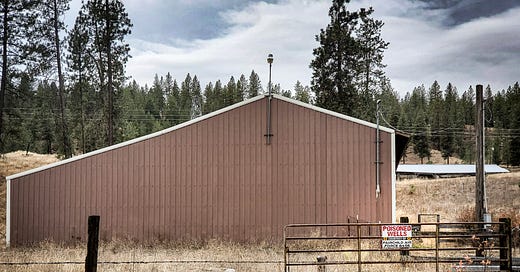John Hancock has a pair of old binoculars on the dash of his dusty, white pickup truck, next to a tiny Buddha figurine and a flamingo ornament dangling from the rear view mirror.
He picks me up from the airport and we wander through back roads around Airway Heights, Washington—an area known as the West Plains. It is a disorienting journey through family farms, used car lots, gravel pit mines, casinos, shipping depots, rail yards, swaths of industrial warehouses, and prison complexes. A push for economic development in the last decades has created a strange, irregular patchwork of big industries interspersed with paint-peeled homesteads waiting to be sold.
The reason for this tour is more than a lesson in economic development, though. We end the tour at the chain link back fence of our destination: Fairchild Air Force Base. Below the economic forces changing the landscape on its surface, an even longer-running tide has been changing the West Plains from underneath, albeit unseen till the last ten years or so. John hands me the binoculars. Airplane hangars line the whole field of view, the whale-like tails of big military transport aircraft jutting out in the distance. The black body of a carcassed fuselage catches my eye.
“Several times a month for 40 years,” he tells me. “That’s where they did their fire training with AFFF,” referring to the foam used for fighting liquid fuel fires, common at military bases, airports, and firefighter training sites. Some 40,000 gallons of foam were sprayed on this site, he tells me, the charred airplane skeleton lit up and doused again and again as an exercise. As a result, the groundwater beneath this spot contains nearly 180,000 parts per trillion of toxic PFAS,1 a truly stunning amount that moves through the aquifer toward the Spokane River, contaminating land and water in its path. Compare that to the maximum allowable level in drinking water, recently set by the EPA, of just 4 parts per trillion for two of the PFAS detected at Fairchild and your head will start to spin.
Wielding both levity and gravitas, John unravels the story of PFAS on the West Plains as we drive. He pulls a map from the dashboard and hands it to me. “These are the paleochannels. You know what those are right?” I don’t. (I was never a very good student of geology). He traces his finger northeast from the base in the direction that the groundwater flows through old river beds, filled in with with trillions of tons of gravel and sand by massive glacial floods during the last ice age. I can’t even fathom it. But the paleochannels are there all the same, funneling PFAS from the air force base to the fields and neighborhoods and drinking water wells of the West Plains.
Land that was once a bounty is now a source of fear and grief. Farmers in the wake of Fairchild have had loan applications for irrigation equipment suddenly denied when it was discovered PFAS were in the water at such alarming levels. Families who moved to the lovely pine-covered bluffs of the West Plains now wonder what will happen to their property values. Some question whether cancer in their community, even deaths in their family, are linked to PFAS in the water (a link that is frustratingly difficult to make, and still being investigated). “Poisoned Wells Courtesy of Fairchild Air Force Base” reads a sign outside one home, a wellhead peaking out from the grass behind. We drive on.
After our tour, John takes me to talk with others in the community who are organizing themselves to advocate for solutions. “A test for everyone who needs one, and a filter for everyone who wants one,” John says. That’s their aim. It’s a good one, and it has resonated with many across the West Plains, so much so that the non-profit that John founded — the West Plains Water Coalition — now has over 450 members.
I’ve been invited here to give a talk on water filters in particular: how well they work for PFAS and how to choose one for your home, a topic I spent several years of my life thinking about during my PhD. I’ve got my slides and citations, my tips and pointers and so on, which perhaps I’ll write about next on this blog. But it’s different when you’re here on the ground with people hearing their stories, witnessing their grief. I feel myself doling out incomplete and unsatisfactory answers. Not because I don’t know the science on this—I do. But the science is full of caveats. And besides, it can’t really say much to people’s pain.
“What can I do about gardening?” one woman asks me, afraid that the PFAS in her well water is contaminating her garden produce. “Now I just throw all my vegetables out and mourn.” I stumble through a response.
“I’m a concerned land owner, and a particularly incensed citizen,” another gentleman tells me. I just nod.




